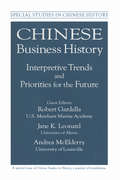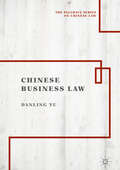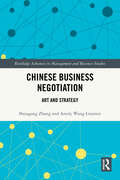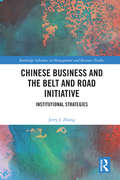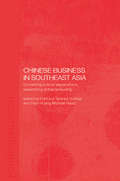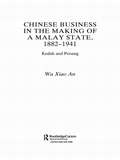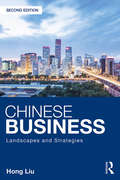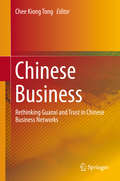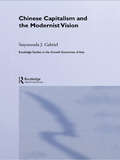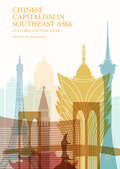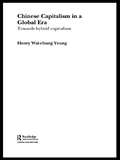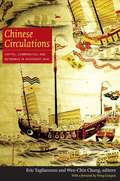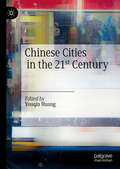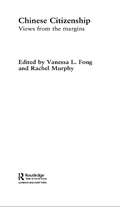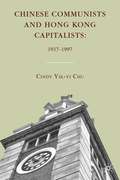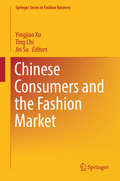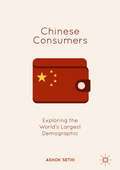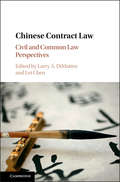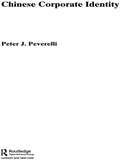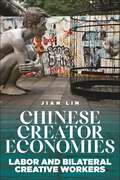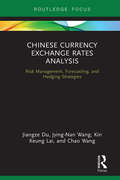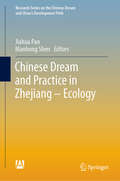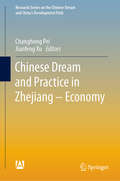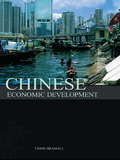- Table View
- List View
Chinese Business History: Interpretive Trends and Priorities for the Future
by Robert Gardella Andrea McElderry Jane K. LeonardThis study focuses on how Chinese business organization, practice, and success have been interpreted in the historical literature. By introducing various interpretations of China's economic development (including the impact of the West, modernization, and Marxist, Weberian, and revisionist approaches), as well as Western business history theory, the book establishes a basis for constructing an appropriate framework for future research.
Chinese Business Law (The Palgrave Series on Chinese Law)
by Danling YuThis book offers the first definitive English-language resource on Chinese business law. Written by an authoritative source, the book accurately describes what the business law is and explains legislative intentions underlying the myriad of law, rules, and regulations. Moreover, it provides the most up-to-date information on law, rules, and regulations and contains accurate predictions of the future legislative trend. It is written for readers across the spectrum of both common law and civil law systems. The author’s experience as expert counsel to Chinese central governmental legislative functions including the State Council Legislative Affairs Office and the expert editor and translator in chief of the national administrative regulations in business and finance, extensive experience of international legal practice and arbitration, and teaching and research experience in international business law and Chinese law will make this book of interest to lawyers, business people, and scholars.
Chinese Business Negotiation: Art and Strategy (Routledge Advances in Management and Business Studies)
by Shougang Zhang Amily Wang GuenierChinese Business Negotiation offers readers a comprehensive insight into Chinese negotiation principles, shaped by centuries of cultural tradition and contemporary global business dynamics. Unlike competitive or zero-sum approaches, Chinese negotiation emphasizes harmony, trust, and long-term partnerships. This book introduces key concepts such as Shi (strategic advantage through interdependence), ethical wealth-seeking, and human-centered, empathy-driven communication.Structured across nine chapters, the book blends historical wisdom with modern business applications, providing practical frameworks for navigating cross-cultural negotiations. Readers will gain an understanding of strategic planning, flexible adaptation, and balanced communication in high-stakes deal-making. Case studies—including Lenovo’s acquisition of IBM’s PC division, SANY’s acquisition of Germany’s Putzmeister, Midea’s acquisition of KUKA Robotics, and Tesla’s negotiations in China—illustrate how these principles drive success in real-world scenarios.This book serves as a valuable resource for business professionals, scholars, and policymakers seeking to deepen their understanding of Chinese negotiation culture. By bridging Eastern and Western approaches, it equips readers with the tools to foster cooperative, mutually beneficial agreements in an increasingly interconnected world.
Chinese Business and the Belt and Road Initiative: Institutional Strategies (Routledge Advances in Management and Business Studies)
by Jerry J. ZhangThis book looks at how Chinese companies optimize investment opportunities while implementing the Belt and Road Initiative (B&R or BRI). Specifically, it studies five high-profile infrastructure projects undertaken by Chinese firms. Going in-depth through case-study analysis, this book fills a gap by providing the background stories of these projects. By applying a case study approach to five notable and representative B&R projects, including Hambantota Port, the Port de Djibouti, and China–Belarus Industrial Park, it is found that strategies of Chinese firms to implement the BRI have been designed to achieve property rights security, reduction of transaction costs, and internalization of benefits overflowing from expanded business scope or multiple business lines. With firsthand data from host stakeholders and on-ground project managers, this book is a highly relevant and valuable text for policy makers and researchers hoping to understand the policy impact and implications of B&R investments on targeted countries
Chinese Business in Southeast Asia: Contesting Cultural Explanations, Researching Entrepreneurship
by Edmund Terence Gomez Hsin-Huang Michael HsiaoPresents empirical findings from different South-East Asian countries to demonstrate that Chinese businessmen employ a variety of strategies in their networking, entrepreneurship and organisational and firm development; and concludes that much more research is needed in order to provide a full understanding of Chinese business success.
Chinese Business in the Making of a Malay State, 1882-1941: Kedah and Penang (Chinese Worlds)
by Wu Xiao AnThis book examines how Chinese family and business networks, focused around activities such as revenue farming, including opium, the rice trade, and pawnbroking, and related legal and labour organization activities, were highly influential in the process of state formation in Malaya. It shows how Chinese family and business networks were flexible and dynamic, and were closely interlocked with economic and social structures, around which government, and states, developed. It considers the crucial role of wealth and power in the process of state formation, and challenges accepted views of Chinese ethnicity and migration.
Chinese Business: Landscapes and Strategies
by Hong LiuIt is difficult to overstate the importance of China to the world economy, and yet the majority of books either look at Chinese business by applying Western frameworks or models to the context of China or focus on a particular aspect of business in China. Authored by an academic expert on China, this new, completely revised edition of Chinese Business offers its readers a comprehensive and systematic body of knowledge of Chinese business. It has taken a holistic perspective, intending to achieve a balance between the academic and practical, between theory and practice and between traditional and current (Internet-based) industry. The framework of this book subsumes all the major factors that should be taken into consideration when Western companies contemplate a China strategy, including history, philosophy, ancient military classics, strategy and marketing, innovation, Internet business and human resources. The discussion of these factors is supplemented with insightful case studies. Chinese Business, Second Edition, can be used as a textbook for undergraduates and postgraduates at business schools and as a useful reference for researchers, senior executives, consultants and government officials involved in Chinese business.
Chinese Business: Rethinking Guanxi and Trust in Chinese Business Networks
by Chee Kiong TongThe nature, institutional foundations, and issues surrounding the apparent success of Chinese business networks is examined in this book. Major concepts such as guanxi, xinyong and gangqing, exploring the nature of trust, relationships and sentiments in Chinese business networks, are re-examined. A significant amount of literature has been devoted to the study of Chinese business, and it largely falls into two broad schools: the culturalist approach, arguing for an essentialist formulation to explain success and the market approach, suggesting that there is nothing inherently unique about Chinese business. This book critiques both these approaches and argues, based on primary data collected in various countries, and with case studies of a large number of Chinese businesses, that another approach, the institutional embedded approach, provides a better explanation for the success, and failure of Chinese business and Chinese business networks.
Chinese Capitalism and the Modernist Vision (Routledge Studies in the Growth Economies of Asia)
by Satyananda GabrielIn the past fifty years, the experience of the Chinese economy has continually challenged the assumptions of laissez-faire economics. It has sustained a strong growth rate, changed the structure of international economic relationships and has become critical to many multinational corporations. Now, it appears to be on the verge of becoming a new economic superpower. Addressing the structure and dynamics of the Chinese economy, Satyananda J. Gabriel examines in-depth the connection between growth and the particular version of Marxism that has been adopted by the Communist Party of China. One of the most comprehensive analyses of the contemporary Chinese economy, this book covers industry and agriculture, rural and urban enterprises, labour power and financial markets, and the process of integrating the Chinese domestic economy into global capitalism. Chinese Capitalism and the Modernist Vision identifies the current transition in China as a historic passage from state feudalism to state capitalism that will significantly alter both the internal political and economic dynamics of China and the global political economy.
Chinese Capitalism in Southeast Asia: Cultures and Practices
by Yos SantasombatThis collection examines the historically and geographically specific form of economic organization of the overseas Chinese in Southeast Asia and how it has adapted to the different historical and socio-political contexts of Southeast Asian countries. Moving beyond cultural explanations and traits to focus on the process of evolution and dynamism of situated practices, it argues that Chinese Capitalism is rapidly becoming a form of 'hybrid capitalism' and embodies the interdependent of culturally and institutionally specific dynamics at local and regional level, evolving and adapting to different institutional contexts and politico-economic conditions in the host Asian economies. This text also explores the social organization and political economy of the so-called overseas Chinese by examining the changing dynamism of Chinese capitalism in relation to forces of globalization. Focusing on key actors, primarily Chinese entrepreneurs in their business practices, and situated practices as well as cultural, political, social and economic factors under globalizing conditions, it provides providing a broad understanding without fixating or homogenizing Chinese capitalism, contributing to the understanding of the contexts that give rise to the emergence and transformation of Chinese Capitalism in Southeast Asia.
Chinese Capitalism in a Global Era: Towards a Hybrid Capitalism (Routledge Advances in International Political Economy)
by Henry Wai-Chung YeungChinese Capitalism in a Global Era examines the dynamic ways in which millions of ethinic Chinese in East and Southeast Asian economies organize their economic activities. It analyses how Chinese capitalism has changed under conditions of contemporary globalization and anticipates what the future holds for it. The book challenges the conventional notion of Chinese cpitalism as 'crony capitalism', based around kinship networks and untouched by globalization.
Chinese Capitalists in Japan's New Order: The Occupied Lower Yangzi, 1937 - 1945
by Parks M. CobleThis book examines the devastating impact of Japan's invasion and occupation of the lower Yangzi on China's emerging modern business community.
Chinese Circulations: Capital, Commodities, and Networks in Southeast Asia
by Eric Tagliacozzo Wen-Chin ChangChinese merchants have traded with Southeast Asia for centuries, sojourning and sometimes settling, during their voyages. These ventures have taken place by land and by sea, over mountains and across deserts, linking China with vast stretches of Southeast Asia in a broad, mercantile embrace. Chinese Circulations provides an unprecedented overview of this trade, its scope, diversity, and complexity. This collection of twenty groundbreaking essays foregrounds the commodities that have linked China and Southeast Asia over the centuries, including fish, jade, metal, textiles, cotton, rice, opium, timber, books, and edible birds' nests. Human labor, the Bible, and the coins used in regional trade are among the more unexpected commodities considered. In addition to focusing on a certain time period or geographic area, each of the essays explores a particular commodity or class of commodities, following its trajectory from production, through exchange and distribution, to consumption. The first four pieces put Chinese mercantile trade with Southeast Asia in broad historical perspective; the other essays appear in chronologically ordered sections covering the precolonial period to the present. Incorporating research conducted in Chinese, Japanese, Vietnamese, Thai, Burmese, Malay, Indonesian, and several Western languages, Chinese Circulations is a major contribution not only to Sino-Southeast Asian studies but also to the analysis of globalization past and present. Contributors. Leonard Bluss, Wen-Chin Chang, Lucille Chia, Bien Chiang, Nola Cooke, Jean DeBernardi, C. Patterson Giersch, Takeshi Hamashita, Kwee Hui Kian, Li Tana, Lin Man-houng, Masuda Erika, Adam McKeown, Anthony Reid , Sun Laichen, Heather Sutherland, Eric Tagliacozzo, Carl A. Trocki, Wang Gungwu, Kevin Woods, Wu Xiao
Chinese Cities in the 21st Century
by Youqin HuangThis book is an interdisciplinary examination of China's new urban development model and the challenges Chinese cities face in the 21st century. China is in the midst of a historic developmental inflection point, grappling with a significantly slowing economy, rapidly rising inequality, massive migration, skyrocketing housing prices, alarming environmental problems, and strong pushback from the West. In this volume, Western and Chinese scholars in different disciplines offer the clearest look yet at some of the main challenges China faces, including domestic and international contexts, the new urban development model, inclusion and well-being of migrants and their families, and urban sustainability. This book sheds light on China’s ongoing development and future directions, and has strong policy implications for anyone interested in the future of China.
Chinese Citizenship: Views from the Margins (Routledge Studies on the Chinese Economy)
by Vanessa L. Fong Rachel MurphyBringing a new dimension to the study of citizenship, Chinese Citizenship examines how individuals at the margins of Chinese society deal with state efforts to transform them into model citizens in the late 1990s and early 2000s. Based on extensive original research, the authors argue that social and cultural citizenship has a greater impact on people’s lives than legal, civil and political citizenship. The seven case studies present intimate portraits of the conflicted identities of peasants, criminals, ethnic minorities, the urban poor, rural migrant children in the cities, mainland migrants in Hong Kong and Chinese youth studying abroad, as they negotiate the perilous dilemmas presented by globalization and neoliberalism. Drawing on a diverse array of theories and methods from anthropology, sociology, education, political science, cultural studies and development studies, the book presents fresh perspectives and highlights the often devastating consequences that citizenship distinctions can have on Chinese lives.
Chinese Communists and Hong Kong Capitalists: 1937–1997
by Cindy Yik-yi ChuThis book examines Chinese Communist activities in Hong Kong from the outbreak of the Sino-Japanese War in 1937 to the handover in 1997. It reveals a peculiar part of Chinese Communist history, and traces six decades of astounding united front between the Chinese Communists and the Hong Kong tycoons and upper-class business elite.
Chinese Consumers and the Fashion Market (Springer Series in Fashion Business)
by Yingjiao Xu Ting Chi Jin SuThis book provides essential insights into Chinese consumer behaviors in the growing and dynamic fashion market. With increasing consumer purchasing power, readily accessible global brands, heavy application of digital technology and social media, as well as growing awareness of environmental issues, the Chinese fashion industry faces great opportunities and challenges at the same time. The contributing authors provide observations and address issues related to middle class fashion consumption, sustainable apparel consumption, technology application in fashion retailing, and the select traditional and new industry segments in the context of China’s recent and massive economic boom. As such, the book offers an invaluable reference guide for all academics and practitioners interested in the Chinese fashion market.
Chinese Consumers: Exploring the World's Largest Demographic
by Ashok SethiThis book offers a comprehensive analysis of Chinese consumers from multiple perspectives, from the megatrends to their values and psychological changes. The book examines in detail the digital and mobile transformation of the consumers, the way their lifestyle, social interactions and shopping habits have changed, and the opportunities they offer to marketers. The analysis and insights are based on the author’s first-hand observations of the metamorphosis of the consumers and consumption in China over the last fifteen years.
Chinese Contract Law: Civil and Common Law Perspectives
by Lei Chen Dimatteo Larry A.This book is the product of a unique collaboration between Mainland Chinese scholars and scholars from the civil, common, and mixed jurisdiction legal traditions. It begins by placing the current Chinese Contract Law (CCL) in the context of an evolutionary process accelerated during China's transition to a market economy. It is structured around the core areas of contract law, anticipatory repudiation (common law) and defense of security (German law); and remedies and damages, with a focus on the availability of specific performance in Chinese law. The book also offers a useful comparison between the CCL and the UNIDROIT Principles of International Commercial Contracts, as well as the Convention on Contracts for the International Sale of Goods. The analysis in the book is undertaken at two levels - practical application of the CCL and scholarly commentary.
Chinese Corporate Identity (Routledge Advances in Asia-Pacific Business)
by Peter PeverelliThis book represents the first study of economic restructuring in reform era China to apply the concepts of identity and corporate space; notions that have become increasingly relevant as foreign invested and Chinese ventures face complex operational and societal issues in the wake of globalization. Peverelli uses his own theoretical framework to examine and detect multiple identities of Chinese enterprises within a larger, comprehensive organization theory. A host of practical case studies taken from Peverelli’s time as a consultant help to illustrate this original theory, while providing a practical reference to the modern Chinese economy and Chinese management. Chinese Corporate Identity will prove a valuable resource to academics working in organization theory, cultural anthropology, sociology, and business and economics. In addition, its supporting case studies will be of interest to consulting firms, foreign embassies and consulates in China.
Chinese Creator Economies: Labor and Bilateral Creative Workers (Critical Cultural Communication)
by Jian LinThe paradoxical relationship between Chinese creative workers and the stateChinese Creator Economies dives into the paradoxical lives lived by creative professionals in emerging economies across China. Jian Lin contextualizes the socioeconomic conditions in which cultural production takes place and pushes back against the dominant understanding of Chinese media as a centralized, state-controlled apparatus by looking at how individual creative workers grapple with governance and precarity in the Chinese cultural industries and develop their bilateral subjectivities within the politico-economic system of Chinese media. Drawing on intensive empirical research conducted on creative labor practices across television, journalism, design, and social media, Chinese Creative Economies looks at both Chinese and foreign-born content creators, exploring the tensions between Beijing’s limits on individual creativity, and its aspirations to become a global hub for cultural production. Lin maintains that it is the production of bilateral creatives that generates and maintains hope for the future of those who live and work within the cultural economies of China.
Chinese Currency Exchange Rates Analysis: Risk Management, Forecasting and Hedging Strategies (Routledge Advances in Risk Management)
by Chao Wang Kin Keung Lai Jiangze Du Jying-Nan WangThis book provides an overview of Chinese RMB exchange markets and its risk management strategies. The view that RMB is playing an increasingly international role has been widely accepted by practitioners as well as scholars worldwide. Moreover, the Chinese government is opening the control of RMB exchange market step by step. However, some related topics are under heated debate, such as how to manage and warn of the currency crisis, what the trend of RMB exchange rate in the future is, and how to hedge the exchange risk in the process of RMB internationalization. In this book, we will give distinct answers to the above questions.
Chinese Dream and Practice in Zhejiang – Ecology (Research Series on the Chinese Dream and China’s Development Path)
by Jiahua Pan Manhong ShenThe theme of this book is the ecological development of Zhejiang province under the guidance of “China Dream” policy. It reviews the policy and strategy for environmental protection and transition from the extensive economic growth model to ecological economy. The author explores ecological theories and practices in areas such as traditional culture, economic development, environmental protection, rural reconstruction, green urban development and the ecological civilization system in Zhejiang. As Zhejiang is one of the first economically well-off regions in China, the challenges faced by the government and its solutions under the guidance of the statecraft shall be of interest to scholars and policy makers worldwide.
Chinese Dream and Practice in Zhejiang – Economy (Research Series on the Chinese Dream and China’s Development Path)
by Changhong Pei Jianfeng XuThe theme of this book is economic transitions of Zhejiang Province under the guidance of “China Dream” policy. It reviews the economic development of Zhejiang Province during the last 10 years and concludes with the experiences and achievements of the local government. As Zhejiang is one of the most economically successful regions in China, the challenges concerning economic transition for the government are a higher priority. This book describes the endeavors and practices that are accomplished by the local administration in system reforms, private sectors, industrial transition and upgrading, ecological harmony, new urbanization, marine economy and open policies. Case studies, live examples and detailed policy interpretations and conclusions are presented throughout this book. The book will assist scholars and policy makers in discovering how the major statecraft has guided and influenced Chinese economy.
Chinese Economic Development
by Chris BramallThis book outlines and analyzes the economic development of China between 1949 and 2007. Rather than being narrowly economic, the book addresses many of the broader aspects of development, including literacy, morality, demographics and the environment. The distinctive features of this book are its sweep and that it does not shy away from controversial issues. For example, there is no question that aspects of Maoism were disastrous but Bramall argues that there was another side to the whole programme. More recently, the current system of government has presided over three decades of very rapid economic growth. However, the author shows that this growth has come at a price. Bramall makes it clear that unless radical change takes place, Chinese growth will not be sustainable.This large, comprehensive text is relevant to all those studying the economic history of China as well as its contemporary economy. It is also useful more generally for students and researchers in the fields of international and development economics.
